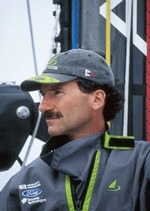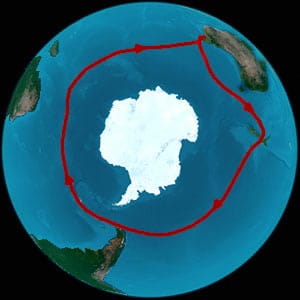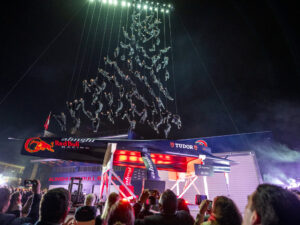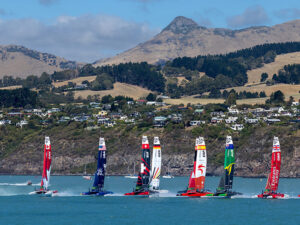
We talked with Paul Cayard last week about his entry into the newly announced Antarctica Cup. Here’s what he had to say:
What led you to throw your hat in the ring for the newly announced Antarctica Cup?
Theyre only allowing three teams per country, I just thought that since there wasnt that much a requirement to enter Id go ahead and grab a slot. The idea is intriguing. First of all, youre sailing around Antarctica, in the Southern Ocean the whole way and thats the best big boat sailing in the world as far as Im concerned. Theyve set it up to be a skins game format; therell be eleven legs. Along the way youve got to pass between the North and South Islands of New Zealand, by Kerguelen Island, and through a bunch of other gates. Each time you pass through a gate theyre going to call it a stage of the race and award prize money for that. So you can really rack up a lot of money, up to 5.6 million dollars. All these different legs give everybody a chance to be a winner at one point or another and yet the race doesnt stop and lay over for three weeks here and there. The whole thing will be over in about 45 days.
Do you think this format will be appealing to the public?
I think so. These things are always hard to know but my sense of it is yeah, very appealing. Its a race that takes place in a very remote area and theres no on-site audience, so theyre going to have to do a good job producing TV and getting it uploaded off the boat. The internets proving to be a good thing for sailing like this.

Will there be a little less privation in this race than in the current Volvo Race format?
The boats are all going to be the same, one-design, and they’re talking about giving us a little bit more comfort. Having a boat that has no heating system in it is a little aggro. Not that you want to warm up the inside of the boat but just so you can get the humidity out of the boat and dry out your innermost layer. Which is what we did on EF Language. That makes a huge difference and its not like you’re carrying around a sauna or something. Hopefully, we’ll see small improvements that wouldn’t detract from the raciness of the regatta but might make it a little more hospitable.
You spent a lot of time preparing for the Volvo with _EF Language _and its obvious that John Kostecki took a page out of your playbook this time around. Youll only get these one-design maxis for the Antarctic Cup two months before the race. Will that give you enough time to ramp it up?
Thats the game, its the same for everybody. To me, thats the most intriguing thing, Ive already started thinking about how Id use my sixty days. I can envision a team that shows up there and theyve already got their food, and everything sitting on the dock. The second they hand over the keys, they just load the boat and boom; they head out for a practice run down to New Zealand for the first twenty days. What are you going to do with your sixty days? Are you going to be fumbling around on the dock because you dont know what youre doing, or are you going to be out really learning the boat?
The entrance price for his event is high, isnt it?
Really high, basically we have to come up with four and a half million dollars but the team will end up owning the boat. Compared to a Volvo campaign, well, look at Kostecki, illbruck has spent an enormous amount, but reasonably, around 15 million dollars. This is going to be four and a half, five million dollars. It’s a reasonable number if the commercial product is done well. It certainly should pay for itself. And then you keep the boat afterwards, so people are talking about what other event you can do with it. We’ve got to do a little consolidating in our sport, it needs a little help on the organizational side. What would make sense would be to have the Antarctica Cup, and the Volvo Race use the same boats. So every four years you’d go around the world in a stopover format like the Volvo and every four years you can do the Antarctica Cup. That means that every two years you’d be doing an around the world race and the equipment would be the same. That would amortize the costs and make some sense. http://www.antarcticacup.com/
The night-racing legs of the 2002 Worrell 1000 have ended and crews have the day off Monday, May 13th before resuming the race. The boats will start for Wrightsville Beach, NC at 10:00 A.M. Tuesday. Steve Lohmayer and Kenny Pierce, sailing Tybee Island stand in first overall, with an elapsed time of 43h:37m:15s, four minutes and one second less than second-place team Castrol, sailed by Jay Sonnenklar and John Casey. last year’ws winners, Brian Lambert and Jay Livingston are in third, eleven minutes behind the leader.
The next three legs could prove to be the most challenging and exciting of this years edition of the Worrell as sailors negotiate their 20-foot catamarans through some of the most dangerous waters on the Eastern Seaboard. Tuesdays leg will take the teams from Myrtle Beach, South Carolina to Wrightsville Beach, North Carolina, directly across notorious Frying Pan Shoals. From Wrightsville Beach, the fleet heads for Cape Hatteras, where the Gulf Stream meets the continental shelf and creates some of the worst localized weather patterns around. In last years race, the fleet waltzed through the area with a minimum of fuss but such is not usually the case. On the Worrell website, http://www.worrell1000.com, is a description of Hatteras from the races organizers, written during the 1999 Worrell 1000. Theyre writing with the respect earned from witnessing the cape at its worst.
“The geography of this race builds inevitably towards Hatteras. It is the ultimate Cape. For when you round it, the fetch is all the way to Greenland. Round it in a noreaster, as the boats did last year, and there is a fantastic blast of wind and water.
“The blast is made worse by the confluence of two great currents, the Gulf Stream from the south, and the Labrador from the north. The currents create shifting shoals miles off shore and curious waves that shoot straight up in the air sometimes twenty-feet or more. The locals call them “piss-ups.” The sailors try to avoid them by rounding Hatteras in a deep channel that generally runs right along the beach.
“Hatteras is a natural surf factory. The thousand fathom line comes within a few dozen miles of the cape. Waves travelling in from the deep ocean hit the continental shelf very close to land, rolling with incredible force upon the sands. Its surfer heaven. Its also danger personified for a twenty-foot catamaran trying to get around.”
Ed Baird has won the Toscana Elba Cup, a match race event held off Elba Island, Italy. In this inaugural year for the event, the Elba Cup had a definite America’s Cup flavor, with teams from Le Defi Areva, GBR Challenge, and Mascalzone Latino all taking part. Baird, sailing for Team Musto, defeated Philippe Priesti (Le Defi Areva), in three straight races to win the finals. Baird takes home over $80,000 in prize money, and the organizers were so pleased with the popularity of the event–Italian television carried the event live for two hours–that they’ve already announced that the event will be held again in 2003. Priesti was second, and claimed over $60,000 and Australian Chris Law was third, with $42,000 in prize money. http://www.elbacup.org
Ellen MacArthur and crew are sailing her Open 60 Kingfisher in the first leg of the Regatta Rubicon, a crewed distance race that goes from St Nazaire, France to Lanzarote in the Canaries, then to Santa Margherita, Italy, near Genoa on the Ligurian Sea. As of early this morning, Team Kingfisher lies in third place, only six miles behind leader Tiscali Global Challenge (ex Whirlpool), helmed by Vendee veteran Simone Bianchetti.
“All well onboard although we had a shocker with the daggerboard just after start and almost lost it out through the bottom of the boat,” said MacArthur on her website, http://www.teamkingfisher.com. “Inevitably we have some computer problems after a complete upgrade, the rule is usually dont upgrade just before a race. But in this case we want to use the Rubicon to really work all our new systems to get them right for the Route du Rhum.
“Everyone onboard is fine, and Kingfisher is not slow – we able to take height at same speed as most, although Bilou(Roland Jourdain on Sill Plein Fruit), rode over us yesterday evening. We are hanging in there though, and happy to be out here. Its been a long time. We lost some miles over night due to a batten problem, we had to lower the mainsail for some repairs, all ok now and back up to speed.”
Nick Moloney, fresh off his victorious run at the Jules Verne Trophy aboard Orange, will rejoin the rest of the Offshore Challenges team on Kingfisher in the Canaries. http://www.regataderubicon.com/accueil_uk.htm
Adrienne Callahan and the crew of Tracey Edward’s giant cat _ Mermaid II_ are attempting to set an Antigua-Newport speed record as part of their ramp-up for their attempt at the Jules Verne Trophy. The first two days of the attempt were positive, with half the distance to Newport covered in the first 36 hours. Unfortunately, Monday is proving to be a bit trying for the crew as they wallow in extremely light conditions.
“More than 18 hours now of drifting, at least during this watch there is a chance of breaking the 9-mile barrier that we hit at the end of our last 4-hour watch,” reads todays crew report. “And we are unlikely to beat the slowest ever speed record for these maxi-cats set by the last watch which totaled three miles in four hours.” http://www.maiden2.com/









